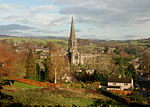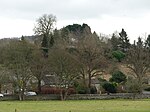Bakewell
BakewellCivil parishes in DerbyshireDerbyshire DalesMarket towns in DerbyshireOpenDomesday ... and 4 more
Pages with Gutenberg book template using bulletTowns and villages of the Peak DistrictTowns in DerbyshireUse British English from February 2021

Bakewell is a market town and civil parish in the Derbyshire Dales district of Derbyshire, England, known for Bakewell pudding. It lies on the River Wye, 15 miles (23 km) south-west of Sheffield. At the 2011 census, the population of the civil parish was 3,949. It was estimated at 3,695 in 2019. The town is close to the tourist attractions of Chatsworth House and Haddon Hall.
Excerpt from the Wikipedia article Bakewell (License: CC BY-SA 3.0, Authors, Images).Bakewell
Bath Street, Derbyshire Dales
Geographical coordinates (GPS) Address Nearby Places Show on map
Geographical coordinates (GPS)
| Latitude | Longitude |
|---|---|
| N 53.214 ° | E -1.676 ° |
Address
Bath Street
Bath Street
DE45 1BX Derbyshire Dales
England, United Kingdom
Open on Google Maps











